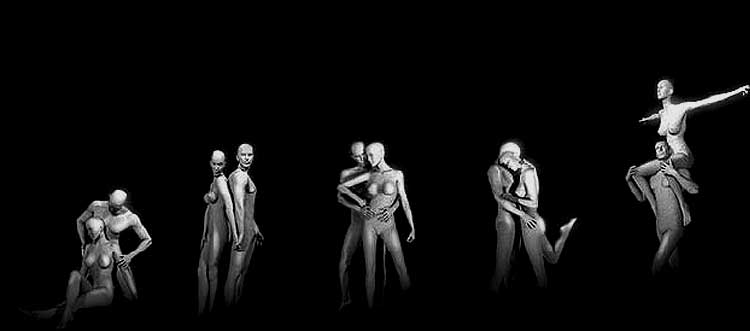Characterizing in 3D: For some important scenes that are not easily realized with conventional production methods (set - camera - actors), I created character and location studies very early on using the semi-professional programs Cinema 4D and Poser. This allowed me to test the audiovisual impact of my counterfactualized symphony in advance. Furthermore, the models serve as valuable templates for the later, elaborate high-end 3D post-production, and scenes already digitally rehearsed can be filmed more quickly and, above all, without costly experiments in the professional production.

Cinematic

Anatomy: As early as the 1980s, I tried to create artificial beings with realistic anatomical structures of their real-life human models, as in the old Viennese school of painting, working from the inside out. This has the advantage that, if the skeletal structure and muscles are already accurate, these beings move very realistically. (See below).

Physiognomy: With new animation programs like Poser, I can now create quite natural movement and action sequences with the test subjects almost instantly and with relatively little effort. These initial virtual scenes were already very valuable in the preliminary stages of translating the story into an illustrated storyboard.

Psychography: The face, modeled three-dimensionally in the computer, for example Bruckner's, can later be realistically recreated by the makeup artist according to specifications. But the character development of a virtual actor is far more exciting, because it is precisely the unmistakable individual personality that ultimately makes a living being so unique. I recreate Bruckner's real-life counterpart, who lived at the end of the 19th century, in the computer until it behaves and acts as authentically as possible, with all its idiosyncrasies, as we know it from contemporary witnesses and accounts. In this way, the great symphonist emerges from "binary digit," does everything that is asked of him—and later, once the scenes are optimized, saves us many rehearsals with the real actors.

Clothes make the person. It's really fun to adjust the wardrobe of virtual characters as authentically as possible, in addition to makeup and hairstyle. From the cut of the underwear and outerwear to the shoes and accessories. This way, every scene can be virtually rehearsed beforehand with the full outfit – in any weather and as often as necessary.
Today, animated protagonists, as 3D avatars, no longer move like robots...
